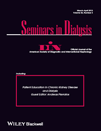Longitudinal Assessment of Hemodynamic Endpoints in Predicting Arteriovenous Fistula Maturation
Abstract
Arteriovenous fistula (AVF) nonmaturation is currently a significant clinical problem; however, the mechanisms responsible for this have remained unanswered. Previous work by our group and others has suggested that anatomical configuration and the corresponding hemodynamic endpoints could have an important role in AVF remodeling. Thus, our goal was to assess the longitudinal (temporal) effect of wall shear stress (WSS) on remodeling process of AVFs with two different configurations. The hypothesis is that early assessment of hemodynamic endpoints such as temporal gradient of WSS will predict the maturation status of AVF at later time points. Two AVFs with curved (C-AVF) and straight (S-AVF) configurations were created between the femoral artery and vein of each pig. Three pigs were considered in this study and in total six AVFs (three C-AVF and three S-AVF) were created. The CT scan and ultrasound were utilized to numerically evaluate local WSS at 20 cross-sections along the venous segment of AVFs at 2D (D: days), 7D, and 28D postsurgery. These cross-sections were located at 1.5 mm increments from the anastomosis junction. Local WSS values at these cross-sections were correlated with their corresponding luminal area over time. The WSS in C-AVF decreased from 22.3 ± 4.8 dyn/cm2 at 2D to 4.1 ± 5.1 dyn/cm2 at 28D, while WSS increased in S-AVF from 13.0 ± 5.0 dyn/cm2 at 2D to 36.7 ± 5.3 dyn/cm2 at 28D. Corresponding to these changes in WSS levels, luminal area of C-AVF dilated (0.23 ± 0.14 cm2 at 2D to 0.87 ± 0.14 cm2 at 28D) with attendant increase in flow rate. However, S-AVF had minimal changes in area (0.26 ± 0.02 cm2 at 2D to 0.27 ± 0.03 cm2 at 28D) despite some increase in flow rate. Our results suggest that the temporal changes of WSS could have significant effects on AVF maturation. Reduction in WSS over time (regardless of initial values) may result in dilation (p < 0.05), while increase in WSS may be detrimental to maturation. Thus, creation of AVFs in a specific configuration which results in a decline in WSS over time may reduce AVF maturation failure.




